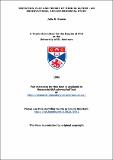Files in this item
Imitation, play and theory of mind in autism : an observational and experimental study
Item metadata
| dc.contributor.advisor | Whiten, Andrew | |
| dc.contributor.author | Brown, Julie D. | |
| dc.coverage.spatial | 395p. | en_US |
| dc.date.accessioned | 2012-07-09T09:02:44Z | |
| dc.date.available | 2012-07-09T09:02:44Z | |
| dc.date.issued | 1996 | |
| dc.identifier.uri | https://hdl.handle.net/10023/2942 | |
| dc.description.abstract | This observational and experimental study takes the Intersubjectivity Theory of Rogers and Pennington (1991), as the guiding line by which to investigate imitation in autism. A deficit in imitation in early childhood is the principal aspect of this theory which distinguishes it from other major theories such as those of Baron- Cohen et al. (1985) and Hobson (1986). With much debate over the existence of a general deficit in imitation, this study aimed first to test for different types of imitation (including those differentiated by Piaget (1962), such as vocal, immediate and deferred imitation) and second, to examine other deficits linked to imitation in Roger and Pennington's theory - emotion perception, joint attention, theory of mind and play. The effect of age was also investigated. Rogers and Pennington (1991) predicted that young autistic children would show a profile of deficits including impaired imitation, emotion sharing, joint attention and pretend play while older children and adults would show impaired "theory of mind", emotion sharing and language pragmatics, relative to controls. In an observational study autistic children and adults showed less social interaction with peers, more manipulative play, less symbolic play in some comparisons and less evidence of mental state understanding but few differences in imitation, compared to children with learning disabilities and normal 3-4 year old and 5-6 year old children. Virtually the same samples were then tested experimentally for the ability to imitate. This was done for (1) elicited imitation (including vocal, simple body movements and symbolic actions, with and without objects), (2) spontaneous, problem-solving imitation and (3) deferred imitation. In addition, spontaneous, elicited and instructed play was tested and visual perspective-taking, joint attention, false-belief and emotion recognition. No general deficit for imitation in school-age autistic children and autistic adults was found, although a younger group (CA 4 - 7 years) of autistic children did significantly worse on all aspects of the task. Scores were lower on deferred imitation and on spontaneous, problem-solving imitation for the autistic groups and certain categories of actions in the elicited task proved more difficult for the autistic children, namely those requiring symbolic ability. Previous findings on joint attention, false-belief and emotion perception were, for the most part, confirmed, although no links between any of these behaviours and imitation were evident from examination of individual profiles. In addition, a picture of inconsistency across tasks emerged. However, some evidence was found for Rogers and Pennington's theory at a crude level, in that it was the youngest children who had most problems with imitation, symbolic play, and emotion recognition, relative to controls. It is concluded that although imitation may be lacking in early autistic development, Rogers and Pennington's theory may not be an altogether satisfactory way of explaining its contribution to the autistic disorder and is, in fact, very difficult to test. | en_US |
| dc.language.iso | en | en_US |
| dc.publisher | University of St Andrews | |
| dc.subject.lcc | RJ506.A9B8 | |
| dc.subject.lcsh | Autism | en_US |
| dc.title | Imitation, play and theory of mind in autism : an observational and experimental study | en_US |
| dc.type | Thesis | en_US |
| dc.type.qualificationlevel | Doctoral | en_US |
| dc.type.qualificationname | PhD Doctor of Philosophy | en_US |
| dc.publisher.institution | The University of St Andrews | en_US |
This item appears in the following Collection(s)
Items in the St Andrews Research Repository are protected by copyright, with all rights reserved, unless otherwise indicated.

